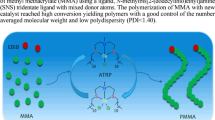Abstract
A new kind of zirconium(Zr) complex containing ligand of salicylaldehyde-imine was successfully synthesized with ZrCl4·2THF and salicylaldehyde-imine as raw materials. The ligand was characterized by means of 1HNMR, IR, and GC-MS, and Zr complex was characterized by means of 1HNMR and IR, respectively. The Zr complex, combined with co-catalyst of Al(i-Bu)3, was explored to be effective catalytic system for the polymerization of butyl methacrylate(BMA), to prepare poly-n-butyl methacrylate (PBMA), which was characterized by IR, 13C-NMR and GPC. Compared with other double-component (MAO/Cat, AlEt3/Cat) catalytic systems, catalytic system of Al(i-Bu)3 and the Zr complex provided the best catalytic activity under the same conditions. The influence of polymerization parameters, such as molar ratio of Al(i-Bu)3/Cat and BMA/Cat, polymerization temperature and polymerization time, was studied with Zr complex/Al(i-Bu)3 system. With increasing polymerization time from 4 to 24 hour, the monomer conversion increased from 40.14% to 96.56%. Viscosity-average molecular weight (Mv) of PBMA, detected by the viscosity methodology, increased from 12.67×104 Da to 44.97×104 Da and lower molecular weight distribution was obtained. According to these results, the Zr complex contained ligand of salicylaldehyde-imine was a kind of readily, long lifetime and high activity catalyst for BMA polymerization.
Similar content being viewed by others
References
Huiqi Z. A Versatile Polymerizalion Technique for Advanced Functional Polymers[J]. European Polymer Journal, 2013, 49(3): 579–600
Bmunecker WA, Matyjaszewski K. Controlled/living RadicaI Polymerization: Features, Developments, and Perspectives[J]. Progress in Polymer Science, 2007, 32(1): 93–146
Grishin DF, Grishin ID. Controlled Radical Polymerization: Prospects for Application for Industrial Synthesis of Polymers[J]. Russian Journal of Applied Chemistry, 2011, 84(12): 2 021–2 028
Hui P, Xiaoqin L, Shiyuan C. Properties of Poly(n-Butyl Methacrylate) Prepared by Reverse Atom Transfer Radical Polymerization in Aqueous Dispersed System[J]. Chinese Journal of Colloid & Polymer, 2004, 22(03): 1–4
Wenjian X, Nianchen Z, Xiulin Z, et al. Atom Transfer Radical Polymerization of Butyl Methacrylate Under Microwave Irradiation[J]. Chemical Research and Application, 2005, 17(02): 223–225
Lei L, WenPing W. Synthesis and Characterization of Polymethyl metharcylate Using Monofunctional Polyhedral Oligomeric Silsesquioxane an Initiator[J]. Polymer Bulletin, 2009, 62(3): 315–325
Jin C, Hong Z, Juan C. Reverse Atom Transfer Radical Polymerization of Methyl Methacrylate Catalyzed by FeCl3·6H2O/MA5-DETA System[J]. Journal of Macromolecular Science Part A, 2005, 42(42): 95–103
Matyjaszewski K, Xia J. Atom Transfer Radical Polymerization[J]. Chemical Reviews, 2001, 101(9): 2 921–2 990
Xu W, Zhu X, Cheng Z, et al. Atom Transfer Radical Polymerization of n-octyl Acrylate Under Microwave Irradiation[J]. European Polymer Journal, 2003, 39(7): 1 349–1 353
Makio H, Fujita T. Development and Application of FICatalysts for Olefin Polymerization: Unique Catalysis and Distinctive Polymer Formation[J]. Accounts of Chemical Research, 2009, 42(10): 1 532–1 544
Carlini C, Martinelli M, Raspolli G, et al. Copolymerization of Ethylene with Methyl Methacrylate by Ziegler-natta-type Catalysts Based on Nickel Salicylaldiminate/methylalumoxane Systems[J]. Macromolecular Chemistry and Physics, 2002, 203(10): 1 606–1 613
DanFeng Z P Z. Synthesis of N-(2, 6-Dialkylphenyl)-2-Furoamide Ni Complex and Its Catalytic Behavior for Polymerization of Methyl Methacrylate[J]. Journal of East China University of Science & Technology, 2011, 5(1): 19–25
Danfeng Z, Sen L, Wen Y. Polymerization of Methyl Methacrylate with α-Diimine Nickel(II)[J]. Chemical Journal of Chinese Universities, 2014(7): 1 559–1 564
Zhengzai C, Kai G, Yang W, et al. Synthesis, Characterization and Application of A Novel Carbon Bridged Half-metallocene Chromium Catalyst for Methyl Methacrylate Polymerization[J]. Journal of Wuhan University of Technology Materials Science, 2014, 29(6): 1 294–1 301
Juan Y, Xinlong W. Thermal Stability of Poly(Butyl Methacrylate)[J]. Modern plastics processing and Applications, 2012, 24(4): 18–21
Author information
Authors and Affiliations
Corresponding author
Additional information
Funded by the Natural Science Foundation of Hubei Province (2017CFB680), the Excellent Youth Project of Hubei Provincial Department of Education(Q20162806), the National Undergraduate Science Foundation of China (No.201510488004), and the Open Foundation of Hubei Province Key Laboratory of Coal Conversion and Novel Materials (WKDM201509)
Rights and permissions
About this article
Cite this article
Cheng, Z., Tang, R., Xie, C. et al. Polymerization of Butyl Methacrylate Catalyzed by Salicylaldehyde-Imine Zirconium /Al(i-Bu)3 System. J. Wuhan Univ. Technol.-Mat. Sci. Edit. 33, 492–499 (2018). https://doi.org/10.1007/s11595-018-1850-7
Received:
Accepted:
Published:
Issue Date:
DOI: https://doi.org/10.1007/s11595-018-1850-7




